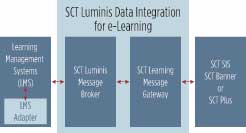SCT Luminis Data Integration for e-Learning
 While 80 percent of institutions have implemented some type of integration
between their student information and learning management systems, it is estimated
that fewer than half have invested in creating the full functionality available
through real-time data integration. Their limited integration can create problems
when student information and learning management systems overlap functionally—e.g.,
between registration and grading—because it encourages “shadow data”
that might easily fall out of synchronization with the institution’s primary
data repository.
While 80 percent of institutions have implemented some type of integration
between their student information and learning management systems, it is estimated
that fewer than half have invested in creating the full functionality available
through real-time data integration. Their limited integration can create problems
when student information and learning management systems overlap functionally—e.g.,
between registration and grading—because it encourages “shadow data”
that might easily fall out of synchronization with the institution’s primary
data repository.
SCT Luminis Data Integration for e-Learning provides real-time, standards-based
data integration between common learning management systems such as those provided
by WebCT and Blackboard with SCT Banner or SCT Plus administrative systems.
This simplifies administrative tasks and reduces data entry redundancies for
faculty; decreases grading policy errors for administrators; and provides students
with seamless, timely access to grades and other data stored in the student
information and eLearning systems.
Southern Alberta Institute of Technology (SAIT), is among the product’s
early adopters. SAIT’s implementation will provide a single sign-on and
data integration services between the institution’s SCT Luminis, SCT Banner,
and WebCT systems. Mark Hoye, manager of software services at SAIT, observes,
“SCT Luminis Data Integration for e-Learning eliminates the need to manually
enter course and student data into our WebCT system. This enables our learning
management system support team to focus on supporting faculty and students.”
He adds that the single sign-on facility will simplify how faculty and students
access the WebCT system and provides SAIT with a connected enterprise system
that enhances the learning experience. “In addition to providing additional
value from the pedagogical perspective, the integration of the three systems
is driving down our transaction costs. The software automates the eLearning
rostering processes, enabling us to eliminate costly, error-prone, and time-consuming
manual data entry practices.”
The solution employs the SCT Luminis Data Integration architecture, an open,
interoperable, and extensible data messaging system. Institutions implementing
SCT Luminis Data Integration for e-Learning gain the benefits of a flexible
software integration resource that can extend the life and utility of their
applications. Institutions and learning management system providers who are
SCT Integration Partners can develop and maintain application software adapters
that work with the product.
Real-Time Data Messaging Capabilities
The standards-based, hub-and-spoke design of the SCT Luminis Data Integration
architecture interconnects disparate systems and legacy applications. At the
heart of this open architecture is the SCT Luminis Message Broker, which incorporates
the Sun ONE Message Queue. The SCT Luminis Data Integration for e-Learning SDK
contains specifications that enable institutions and SCT Integration Partners
to develop application adapters that communicate with the SCT Luminis Message
Broker.
Predefined events trigger the transmission of data messages from an
application to the message broker, which then publishes those messages to the
list of networked applications denoted as subscribers. The SCT Luminis Message
Broker also tracks which application is the authoritative source for a given
data set to ensure the data integrity of that source.
The product brings the benefits of real-time, event-triggered, data message
integration between an institution’s learning management and student information
systems.
Students, faculty, and administrators can benefit from real-time synchronized
data, especially when these data are important to their individual needs and
performance objectives. The solution ensures data integrity in support of inter-office
processes for course catalog management, class scheduling, class enrollment,
registration add/drop, grade books, and other academic information sources.
SCT Luminis Integration for e-Learning is the second real-time integration
solution released by SunGard SCT. SCT Luminis Data Integration for e-Procurement,
for coordinating purchasing, accounting, and financial management operations,
was released earlier this year.
For more information about SunGard SCT, visit www.sct.com.